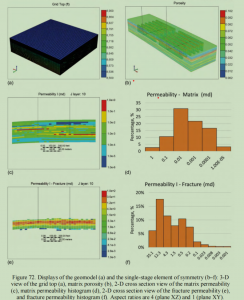Improved Characterization and Modeling of Tight Oil Formations for CO2 Enhanced Oil Recovery Potential and Storage Capacity Estimation
Abstract
Tight oil formations such as those in the Bakken petroleum system are known to hold hundreds of billions of barrels of oil in place; however, the primary recovery factor for these plays is typically less than 10%. Tight oil formations, including the Bakken Formation, therefore, may be attractive candidates for enhanced oil recovery (EOR) using CO2. Multiphase fluid behavior and flow in fluid-rich shales can vary substantially depending on the size of pore throats, and properties such as fluid viscosity and density are much different in nanoscale pores than in macroscale pores. Thus it is critical to understand the nature and distribution of nano-, micro-, and macroscale pores and fracture networks.
To address these issues, the Energy & Environmental Research Center (EERC) has been conducting a research program entitled “Improved Characterization and Modeling of Tight Oil Formations for CO2 Enhanced Oil Recovery Potential and Storage Capacity Estimation.” The objectives of the project are 1) the use of advanced characterization methods to better understand and quantify the petrophysical and geomechanical factors that control CO2 and oil mobility within tight oil formation samples, 2) the determination of CO2 permeation and oil extraction rates in tight reservoir rocks and organic-rich shales of the Bakken, and 3) the integration of the laboratory-based CO2 permeation and oil extraction data and the characterization data into geologic models and dynamic simulations to develop predictions of CO2 storage resource and EOR in the Bakken tight oil formation. A combination of standard and advanced petrophysical characterization techniques were applied to characterize samples of Bakken Formation tight reservoir rock and shales from multiple wells.
Techniques included advanced computer tomography (CT) imaging, scanning electron microscopy (SEM) techniques, whole-core and micro x-ray CT imaging, field emission (FE) SEM, and focused ion beam (FIB) SEM. Selected samples were also analyzed for geomechanical properties. X-ray CT imaging yielded information on the occurrence of fractures, bedding planes, fossils, and bioturbation in core, as well as data on bulk density and photoelectric factor logs, which were used to interpret porosity, organic content, and mineralogy. FESEM was used for characterization of nano- and microscale features, including nanoscale pore visualization and micropore and pore throat mineralogy. FIBSEM yielded micro- to nanoscale visualization of fracture networks, porosity and pore-size distribution, connected versus isolated porosity, and distribution of organics.
Results from the characterization activities provide insight on nanoscale fracture properties, pore throat mineralogy and connectivity, rock matrix characteristics, mineralogy, and organic content. Laboratory experiments demonstrated that CO2 can permeate the tight matrix of Bakken shale and nonshale reservoir samples and mobilize oil from those samples. Geologic models were created at scales ranging from the core plug to the reservoir, and dynamic simulations were conducted. The data from the characterization and laboratory-based activities were integrated into modeling research activities to determine the fundamental mechanisms controlling fluid transport in the Bakken, which support EOR scheme design and estimation of CO2 storage potential in tight oil formations. Simulation results suggest a CO2 storage resource estimate range of 169 million to 1.5 billion tonnes for the Bakken in North Dakota, possibly resulting in 1.8 billion to 16 billion barrels of incremental oil.


